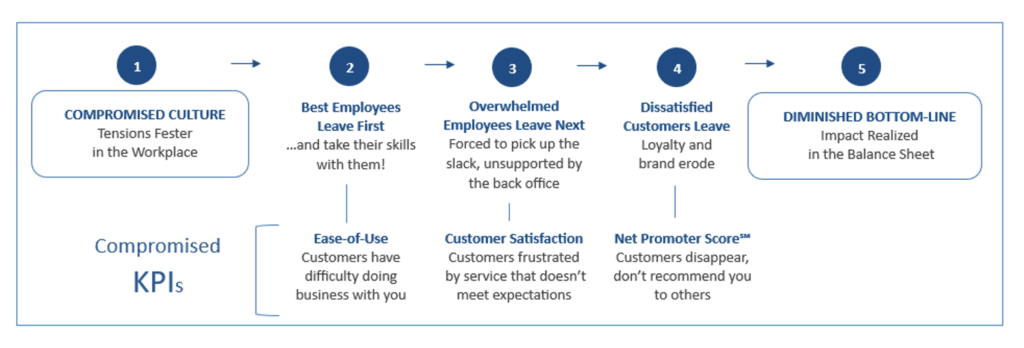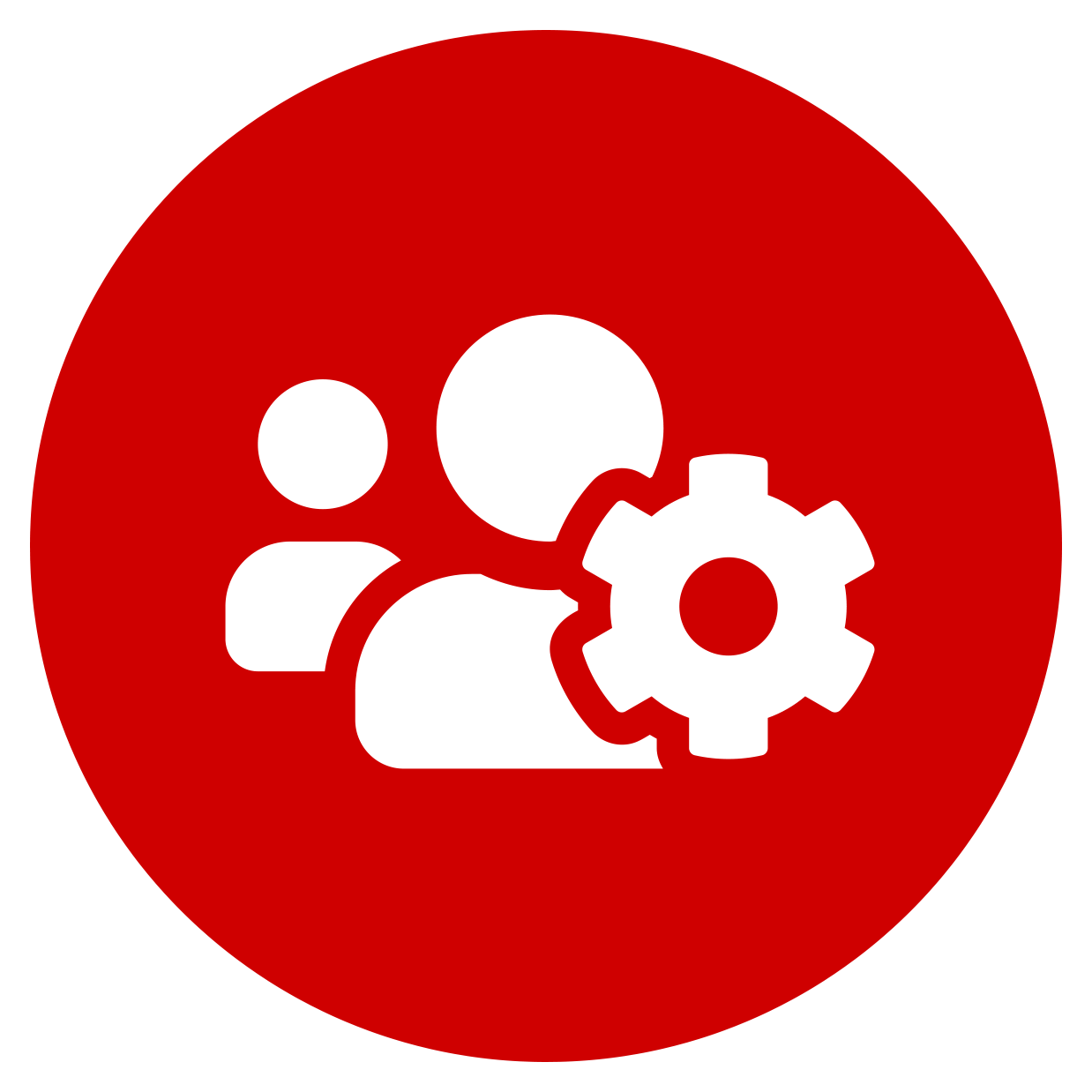How do you know when to act to keep hotspots and tensions in workplace culture from harming your customer experience – and your bottom line?
An inarguable (and often inconvenient) fact is that a great customer experience (CX) begins with a great employee experience (EX). Further, a great customer experience goes hand-in-hand with revenue growth and profitability, as your satisfied customers stay with you, do more business with you, and refer you to others.
Writing in Harvard Business Review, one brand consultant highlights the dependent relationship of EX and CX:
With all its moving parts, the customer experience requires the consistent, cohesive engagement throughout the organization that EX excellence can foster. To tap the power of EX to create compelling CX, business leaders must align the two, directly connect employees and customers, and use tools and processes to identify and report on the impact each has on the other. [1]
This article will help you to understand why tackling the elephant in the room – namely, the tension in your banking workplace culture – will help you avoid negative outcomes, including a hit to your balance sheet. And it will show you how to do that by tapping the power of EX to create compelling CX.
Imagine asking other executives that question: “Just HOW do we tap the power of EX to create compelling CX?” If you bring that as a challenge question to an executive meeting, you will find most executives staring off into the sunset.
But think about it: where there is no answer to this pressing question; no strategy; and no day-to-day processes, tools and reporting to ensure that you are tapping into the power of EX to create compelling CX – your customers will see the (negative) results. Then they’ll let you know about it, either with complaints or by taking their business elsewhere.
With the EX disconnected from the CX, you’re losing the exponential (positive!) impact this dynamic should be having on your bottom line. And THAT should grab your attention!
The Insidious Lag Time
How do you repair the EX/CX disconnect that hurts your bottom line – or better still, how do you keep it from emerging in the first place? In many cases, tensions within and among teams lie beneath the surface, festering untreated until there’s an undeniable impact on your customer service. And once customer service starts falling below customer expectations due to teams that don’t work well together, you see the ultimate effects in your balance sheet.
It’s easy to say that your goal is a vibrant workplace culture with teams focused on your organizational mission. But when things start to go awry, the longer you wait, the harder it is to restore your culture to health.
Given that you embrace the idea that a compromised banking workplace culture takes its toll on the bottom line, your best strategy is a means of detecting, at early stages, the friction within and across teams, as well as the dissatisfaction throughout the organization at large. The sooner you can detect these problems, the sooner you can remedy the issues that will compromise not only the customer experience but ultimately the balance sheet.
I find that although most executives – particularly at the senior level – have that instinctive perception that something is afoot, they tend to walk a bit in denial – hoping that it gets better or just goes away. Then, tangible symptoms start emerging that can’t be ignored. It is in that lag time between perceptively knowing something is wrong and seeing the presenting symptoms where the insidious forces that undermine a culture metastasize – all the way through the organization to the customer experience.
The Tangible Symptoms
It’s in the undeniable realities that hopes of the situation just “getting better on its own” are dashed. What are these realities, you ask? Let’s start with the earliest tangible symptoms – what are considered leading indicators; then we’ll work toward the lagging indicators. This gives you the means to self-assess where your organization sits today: is your banking workplace culture healthy, or are you in the early stages or the late stages of a culture gone awry?

The erosion of workplace culture starts with teams that can’t or won’t work well together. Each department is looking to meet its own objectives rather than focusing on the shared organizational mission. Habits of open communication, collaboration, and empathy are conspicuously absent. When employees do not feel connected to the larger purpose of the business, the walls isolating teams from each other become thicker and higher.
In such a compromised environment, your top frontline talent becomes discouraged and disengaged. Eventually they leave the organization for more meaningful opportunities to use their skills. Your remaining employees, forced to pick up the slack and unsupported by the back office, become overwhelmed. Eventually, they contribute to the rapid turnover.
As your more skilled, experienced employees leave, customer service struggles to meet customer expectations. Not only do frustrated customers take their business elsewhere, you fail to build new customer relationships. Only after these cascading events have occurred do you see the most lagging indicator of your compromised culture and sub-par customer service: the bottom-line impact on your balance sheet.
If only there were something to sound the alarm before it got this far!
Enter: Key Performance Indicators (KPIs)
True, conventional CX Key Performance Indicators (KPIs) like Ease-of-Use, Customer Satisfaction, and Net Promoter Score® can alert you to workforce issues that threaten your bottom line. But by the time they do, those issues have already impacted the customer experience!
As the illustration above shows, conventional KPIs run alongside the path of cultural collapse. The earlier the indicator, the more opportunity you have to take action. The more lagging the indicator, the less time you have to stop the slide before its ultimate outcome. But all of these KPIs measure from the customer perspective.
Now back up a step: because the root of the CX problem lies within your culture, a KPI that measures within your workplace can alert you to internal issues BEFORE their effects “spill over” to your customer service. A KPI like eNPS, or a similar metric that “takes the pulse” of your customer-facing teams (and the back office teams that support them), can give you the preemptive intel you need to intercept problems before they lead to frustration for your customers.
So there is hope! The habits and behaviors of a deteriorating banking workplace culture are detectable, even in the early stages, and fixable, even in the later stages. But you can’t shore up the teams that deliver your customer experience unless you can pinpoint with exactness where and how they are falling short.
Act Now. Right Now. Here’s How.
Keep in mind: KPIs alone fix nothing! The right action is needed to remedy the situation. As I noted, the most lagging indicator of a compromised culture is the impact on the balance sheet. By that time, the turnaround is harder because cultural issues are deeper and more entrenched. That’s why staying vigilant to the employee experience – and acting to avert bad effects on your customer experience – can give you a competitive advantage: it lets you act before your customers even know that there is an issue.
When should you attempt to “treat” issues in your banking workplace culture that contribute to the EX/CX disconnect? As soon as you are aware of them. The longer you let them fester, the harder it is to recover. By the time a CX issue gets on the C-level’s radar, you can be sure it’s already taken root – deep and wide throughout your organization. If it’s reached the C-level, it’s already impacted the customer experience.
Only when you really “get under the hood” of what’s driving your internal culture can you see what is fueling the underlying tension. When you have intel that gives you a clear line of sight to your root issues, you can act more precisely and drive to outcomes that spark a cycle of success – exponentially.
As always, there is expertise here to help you educationally, strategically, and practically – Get in touch today.
[1] Lee Yohn, Denise. “Engaged Employees Create Better Customer Experiences,” Harvard Business Review, April 5, 2023.
Net Promoter®, NPS®, NPS Prism®, and the NPS-related emoticons are registered trademarks of Bain & Company, Inc., NICE Systems, Inc., and Fred Reichheld. Net Promoter ScoreSM and Net Promoter SystemSM are service marks of Bain & Company, Inc., NICE Systems, Inc., and Fred Reichheld.






















